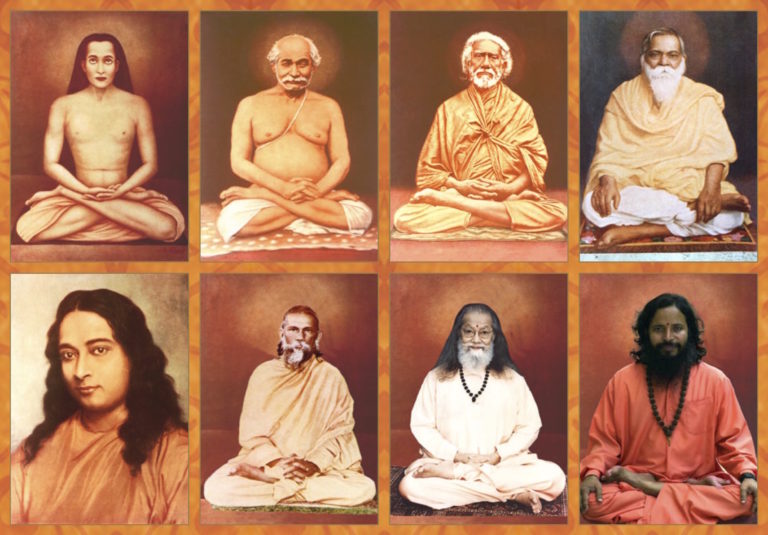
Action is the essence of this universe. Everything is in action. From the sun, the moon, the earth, and the stars to even the smallest of the particles like atoms are constantly moving to achieve some or the other thing. Nothing is fixed in this beautiful creation. The universe is constantly active, changing its course to maintain steadiness in its systems as a whole.
So is our body. It has its systems constantly performing some or other functions to let us experience the world better. But still, it acts as a stable system as a whole. To let our bodily systems offer this complete experience of the world to us, we first need them cleansed and purified.
The cleansing process of all our bodily and mental systems is called Kriya Yoga. It is the exercise that, if performed sincerely, frees the yogi from the cycle of causation of this universe, in short, Karma.
What is Kriya Yoga?
The word Kriya in Sanskrit is defined as “Kri” means karma or action and “ya” means soul. Thus, kriya yoga literally translates to the union through the action of the soul.
Here, karma is specifically meant for purificatory action to clear the obstacles that come in the way of yoga practice. Hence, Kriya Yoga is the practice of purifying the physiological as well as mental and spiritual systems.
It clears the systems for better activated operations and leads a yogi’s path to higher truths about their inner self. For this reason, Kriya Yoga is also called the “process of action”. Its purpose is to cleanse the network for attaining the higher goal, which is Absolute Consciousness.
The practices of Kriya Yoga are performed to purify the systems so that the yogi is enabled to receive greater knowledge with totally sterilized networks. It is thus termed as the practice of purification. The Kriya Yoga throws out the unnecessary, unsound fragments from your body and mind and clears your way to reaching higher levels of existence.
Kriya Yoga According to Yoga Sutras
Purificatory actions are the way to self-enlightenment. That’s why Patanjali has included the three major aspects of Kriya Yoga in his Yogasutras.
He mentions in the second chapter, first verse as
‘Tapaha Svadhyaya Ishvara-pranidhana Kriya-yogah’
Yoga Sutras 2.1
Translation – The combined practice of tapaha= “austerity”, svadhyaya = “self-enquiry” and Ishvara Pranidhana = “surrendering to the God” is called Kriya Yoga.
Patanjali elaborates on these three aspects as the practices of Kriya Yoga to attain higher spiritual goals.
A kriya is called to that karma “which is done for the soul” or which frees us from the “bondage of karma” by burning physical and mental impurities.
Therefore, Tapas works at the very first step in the Kirya yoga journey. Tapas prepare our body and mind for action through austerity. Patanjali describes the practice of Tapas in the form of yoga sadhana which induces internal heat to burn off physical and mental impurities.
Then comes the second step; Svadhyaya. Svadhyaya means self-inquiry, it lets our consciousness inward to the self. As described by Patanjali, Svadhyaya is self-analysis through contemplation and study of scriptures. It is an aspect of Kriya Yoga through which the yogi’s mind is purified by the right knowledge and expansion of his sense of self.
The last element of Kriya Yoga is Ishvara Pranidhana. It expresses surrendering all the attachments, desires, and egoistic feelings to God. The practice of Ishwara Pranidhana connects the individual self to the universal self. This is the spiritual exercise that the yogi is supposed to perform for attaining the higher Truth.
Kriya Yoga in Bhagavad Gita
Kriya Yoga as a practice of action is also extended by Lord Krishna in the Bhagavad Gita. In discourse four, he explains that ‘offering the inhaling breath to exhaling and offering the exhaling breath to inhaling breath, a yogi balances his breath and thus releases Prana to bring his bodily systems under control to act together in synchrony’.
This stanza explains the importance of bringing balance in every action of ours. Just as the universe, though moving, keeps its balance, a yogi should neutralize even the aspects of Prana to achieve steadiness.
In the next context, Lord Krishna says that a yogi when withdraws himself from all the external happenings by fixing his focus between the eyebrows and regulates his sense of mind and intellect, is free from all the bondage.
Here, he has emphasized the importance of the cleansing process of one’s body, mind, and intellect to transcend to the subtler levels of consciousness.
How Kriya Yoga is Different from Other Yoga Styles?
As we have read in the previous sections, Kriya Yoga includes the practice of Asanas, Pranayama, and spirituality. However, Kriya Yoga has a deeper purpose than just toning your body. It focuses more on the mental and spiritual benefits by the means of physical exercises.
We possibly tend to confuse between the Hatha and Kriya Yoga styles. Hatha implies force. It is the technique of energetic exercises that improve your strength and stamina. As opposed to Kriya Yoga, which, along with careful and steady physical exercises, asks a yogi to effortfully study and devote himself on the path of Yoga.
Because it has a major devotional component, many people can associate Kriya Yoga with religion. It is not so. Kriya Yoga is a practice of spiritual awakening of a person. This spiritual awakening is achieved with the help of meditative practices, contemplation, self-study, and surrendering of one’s ego.
Kriya and Kundalini are also thought to be the same by many. They both are the ‘Yoga of awareness’, however, they differ in their purpose. Kundalini yoga is a physical and mental practice helpful for purifying the body and mind. But Kriya Yoga aims at spiritual growth by means of balancing one’s breath.
History of Kriya Yoga

Kriya yoga as a technique of physical, mental, and spiritual upliftment was discussed centuries ago by Sage Patanjali in Yoga sutras. However, its most scientific forms were brought to us first by Mahavatar Babaji Maharaj through his disciple Sri Shyama Charan Lahiri Mahasaya in 1861.
Sri Shyama Lahiri Mahasava passed this sacred knowledge onto Swami Sri Sri Yukteshwar Giri and his other disciples. Paramahansa Yogananda and Paramahansa Hariharananda were the disciples of Sri Sri Yukteshwar Giri and absorbed the knowledge of Kriya Yoga from their master. Later, Paramahansa Yogananda spread the proper practices of Kriya Yoga on his journey to the United States.
It is essentially learned via the Guru-disciple relationship which was prevalent in ancient India. Hence, first the Guru passed on the vidya (teaching) to his students and the students, upon contemplating on it, spread it to their own disciples and so on. This is how the great tradition of Kriya Yoga finally got popularized when Yogananda presented it.
The methods of Kriya Yoga as discussed by Babaji Maharaj consist of a number of Pranayama levels that are intended to accelerate a yogi’s spiritual awakening and to be able to make his communication with God happen.
Paramahansa Yogananda in his famous book ‘Autobiography of a Yogi’ discusses that doing even a half-minute of Kriya influences the subtle aspects of a man’s evolution. He says that half-minute of kriya yoga practice is equal to one year of spiritual unfoldment.
After Paramahansa Yogananda, Haricharananda existed as a teacher of Kriya Yoga until 2002. After his demise, his disciple, Paramahansa Pajnanananda continues to take the teachings forward.
Practice of Kriya Yoga
Kriya Yoga practices are based on the principle that controlling your breath helps control your mind. For this reason, it consists of a number of practices involving breath, brain, and the spinal cord that bring balance in your Prana and lead one’s spiritual journey forward.
Generally, the practice of Kriya Yoga needs initiation by a teacher from Parahamansa Prajnanananda linage. The teacher will introduce you to the basic Kriya Yoga techniques. There is no discrimination as to who can get initiated, the wilful efforts for spiritual transformation being the only exception.
After this, a purification ceremony takes place. The yogi must avoid using alcohol, caffeine, or other excitatory substances before the ceremony. He is asked to wear comfortable clothes, the ones that would not distract him in the practice. A combination of mantras and sound vibrations transmits the energy and light in the participants.
In the next fire ceremony, the systems are cleansed at a deeper level. After this, the first level of Kriya techniques is taught to the participants and they are asked to learn and practice them throughout the purification process.
After this, the initiated participant must offer symbolic gifts. They can be five fruits that represent Karma, five flowers that represent senses, and monetary donation. Then, the participant is asked to fill a form and resolve not to share the techniques. In the follow-up sessions, different meditative practices are conducted.
Kriya Yoga Techniques and Stages
Kriya Yoga practices are gradual, one after the other, divided into six stages.
First Stage
The first stage involves Kriya Pranayama, in which the participants achieve combining the energies of Prana and Apana. Before beginning with this practice, the flow of prana is actually blocked from the Ida and Pingala. When this pranayama is performed, an equilibrium is attained and the flow of prana is directed to Sushumna, the subtle part.
Second Stage
In the second level, all the Chakras in the body are worked upon, with special attention to the heart chakra. This phase is about awakening them and transcending them. Here, the pressure of prana on each chakra is stronger as the participant has progressed in the Kriya Pranayama.
Third Stage
The third stage of Kriya Yoga characterizes stronger emphasis on the heart chakra. It is the place of the immortal self and thus is focused more. Experts on Kriya Yoga say that if the participants practice this stage long enough, there is no necessity to perform the other stages.
Fourth Stage
In this particular stage of Kriya Yoga, once the heart chakra is activated and keeping those activations intact, the yogi can apply emphasis on all the other chakras. If enough focus is given to the Muladhara chakra, it can lead to the expansion of awareness. In this stage, the breath is largely internalized, feeling like a breathless state.
Fifth Stage
In the fifth stage, the participants shift their attention towards the energy flowing towards Muladhara while remaining outside the spine. It is purely an experiential level that belongs to the world beyond words and common understanding.
Sixth Stage
The sixth stage emerges in the form of opening the spinal cord. This stage is considered equivalent to the transcendental phase where the yogi meets the True Reality. He leaves the sense of time and space and reaches the level of Asamprajnata Samadhi, which leads the way to Kaivalya or absorption.
Benefits of Kriya Yoga
The deeper meditative exercises proposed by Kriya Yoga offer a vast range of benefits including turning negative emotions into positive ones. This is done by practicing better concentration and breathing techniques.
With breathing exercises, a calmer mental environment is created. It accelerates a person’s ability to assess his own thoughts and quiet them if found disturbing. The concentration level increases and the person is able to discriminate better between right and wrong.
Kriya Yoga is the technique of complete transformation from physical to subtler aspects like a person’s spiritual connections. Through regular practice, the yogi can let go of the false egoistic identification with the body and mind and goes nearer to his true self, which is infinite.
The practice of Kriya Yoga eliminates all the negativity from the yogi’s body. Physically, he becomes more energetic and productive, leading an active and interesting routine. Also, with expanded consciousness, he completes challenging tasks with taking no credit for the work done. Kriya Yoga also develops a habit of gratitude.
As a result of an energetic physical routine, the Kriya Yoga techniques increase our power of healing. It enhances the capacity of our immune system to let us fight better with illness. After regular Kriya Yoga exercises and the purification they do, the nervous system becomes stronger, maintaining our mental responses balanced.
Final Thoughts
The essence of Kriya Yoga lies in its integration of keeping our body, mind, and spirit in a rhythm. From Lord Krishna, Sage Patanjali to Babaji Maharaj and Yogananda, Kriya Yoga may have evolved in terms of practices but not in its purpose.
The term Kriya Yoga itself signifies the action processes that are needed to purify and align our physical, mental, and spiritual systems. This task is beautifully done by different Kriya Yoga exercises to eventually bring us closer to identifying ourselves in the truest sense.
The process of transformation needs action. As the entire universe works on the principle of action or movement, we as divine souls in the physical body also require the same. Only action can move us, modify us, change us, and encourage us to reach our fullest potential. And as the Yoga of Action, Kriya Yoga can be our helping hand in this process of transformation.





HI Ashish,
Thanks for teaching Kriya Yoga in such a thoughtful and kind way. Jesus had thirty years to learn the benefit of breathing exercises before returning to Jerusalem.
Breathing can not alone awaken chakras. Infinite, agapic Spirit lifts things up even for the least of us.
Ashish
I spent many years in the Arcane school of the Lucis Trust and have also been a member
of the Theosophical Society in London. Both of these organisation seem to frown upon any spiritual disciplines that involve breathing exercises, saying that they can pematurely awaken certain energy channels and centres before the aspirant is fully ready, also claiming breathing exercises are dangerous. Both schools are “Eastern” in their origins. Should this put me off the path of kriya Yoga ??
Namaste
Thank you for sharing your background and concerns. It’s understandable that different spiritual traditions may have varying perspectives on certain practices, including breathing exercises.
Kriya Yoga, as taught by different lineages, does involve breath control techniques. If you have reservations based on your experiences with the Arcane School and Theosophical Society, it may be beneficial to explore Kriya Yoga under the guidance of a qualified teacher who can address your concerns and provide personalized guidance.
Ultimately, the decision to pursue Kriya Yoga is a personal one. Feel free to reach out if you have further questions or if there’s anything specific you’d like to discuss.